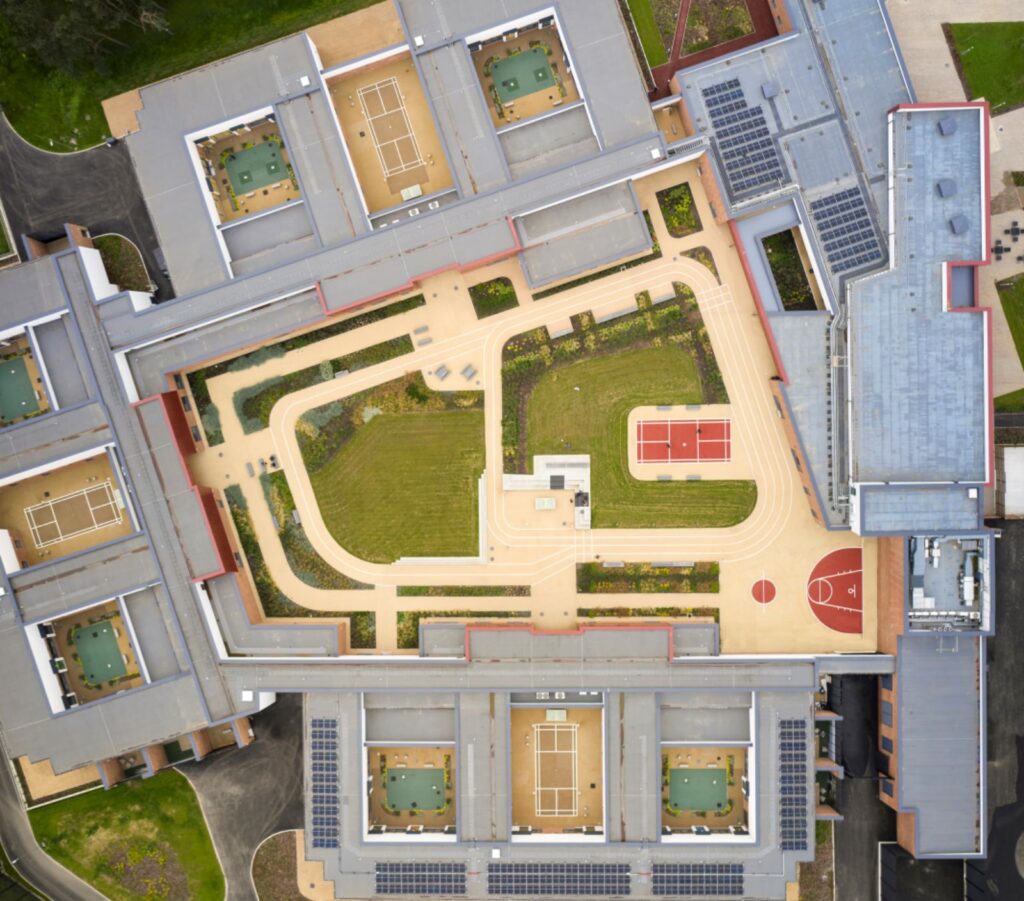Sycamore at Northgate Park Hospital by Medical Architecture

Developed around the concept of a ‘village campus’, a new medium secure hospital at the heart of the £60m redevelopment of Northgate Park Hospital, provides a wide variety of indoor and outdoor settings for relaxation and activity, relieving boredom and addressing the risk of challenging behaviours and poor physical health.
The consolidation of services
The new facility is the catalyst to allow all secure services across the Trust to be brought together from previously dispersed sites, consolidated in a single, integrated secure centre of excellence. The entire redevelopment provides a total of 116 male inpatient beds, located in a combination of new and reconfigured existing buildings.
The new-build element, named Sycamore, provides inpatient accommodation for 72 male patients with a range of forensic mental health needs, including patients with complex personality disorders and/or learning disabilities. The project, which was delivered through Cohort 1 of the NHS New Hospital Programme, fulfils one of the Trust’s key strategic priorities, forming part of their £72.6m Care Environment Development and Re-provision programme (CEDAR).
A meaningful day in a unique woodland setting
The existing hospital site is a large open campus, containing a mix of buildings and facilities. Much of the eastern portion, which was earmarked for development, is neighboured by a broad area of mature woodland. Early feasibility work demonstrated benefits to siting the new hospital where it would be flanked by an aspect of trees on three sides: the natural setting enhancing the therapeutic nature of the accommodation.
As a result, the facility is devised as a ‘village campus’ focusing on the individual patient and staff experience, with as many spaces as possible, both inside and out, offering opportunities for mitigating boredom. This is achieved in a range of settings that can be accessed autonomously, from bedrooms to living spaces, and sheltered gardens to open courtyards, with opportunities for both structured and unstructured sports and activities.
An inclusive outdoor space for communal wellbeing
The six patient wards are paired together and arranged around a large recreation courtyard. Each building is adjoined, creating a secure boundary without the need for fences, minimising the feeling of confinement. With rich landscaping and integrated security measures, this shared space does not feel like a typical forensic mental health facility.
The courtyard is separated into two distinct character zones—‘Passive’ and ‘Active’—to ensure that all patients and staff are able to benefit from its therapeutic qualities. The ‘Passive’ zone provides opportunities for refuge, with restful places to sit amongst plants and grasses. These smaller-scale spaces offer a sense of enclosure, combined with views out to the wider recreation area to provide gentle enticement into the activities offered.
The ‘Active’ zone includes a 200m jogging/walking loop, activity spaces and a fitness ‘trim trail’, to promote physical activity and the associated wellbeing benefits. Within the main reception building—which provides the public frontage to the facility—a covered sports barn allows activities to continue in all weather conditions.
Choice of open or private outdoor space
In addition to these communal spaces, at the centre of each ward, a private landscaped courtyard for relaxation is provided, and between each ward pair is a designated activity courtyard, with sports court markings. Abundant daylighting, attractive views and a sense of spaciousness contribute to the therapeutic qualities of the environment and play an important role in patient rehabilitation.
Personal spaces for individual wellbeing
Whilst use of the common spaces is actively encouraged, it was acknowledged that this patient group may choose to spend time in their own room, particularly in the morning and evening. To maximise the opportunity for activity, the design of the bedrooms stemmed from a detailed re-imagining of how these spaces could work.
Adequate floor space for exercise, and a television which can be easily viewed from the bed or floor, enables a patient to either be active or to rest. The bedroom corridors are single-sided, with immediate views to the landscaped ward courtyards from each bedroom door, providing orientation, good observation and balancing circadian rhythms.
Challenging the stigma around mental healthcare
The exterior appearance of the new facility is extremely important and has a major role to play in reducing the stigma surrounding mental illness, as well as engendering pride in the building as a workplace. A visible and publicly accessible café with integrated artwork provides a welcoming space for visitors and staff working across the site. Source by Medical Architecture.
Location: Morpeth, United Kingdom
Architect: Medical Architecture
Services Engineer: CAD21
Structure and Civil Engineer: Billinghurst George & Partners
Landscape Design: Colour
Fire Safety: Centurion Fire Safety Solutions
CDM Coordinator: Richmond Safety Services
Acoustic Engineer: SRL Technical Services
Project Management: Projeeco
Art Consultant: Dan Savage Artstop Studios
Building Control: Bluekeep Building Control
BREEAM Consultant: Tetra Tech
Contractor: Sir Robert McAlpine
Foundation: Trust
Client: NTW Solutions – Cumbria, Northumberland, Tyne and Wear NHS
Value: £60,000,000
Completed: September 2023
Photographs: Richard Chivers, Courtesy of Medical Architecture





